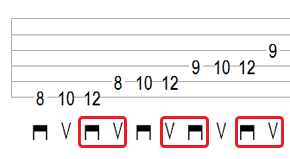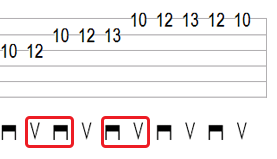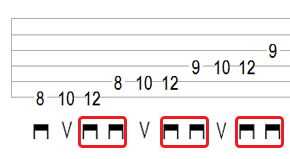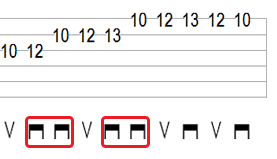fast guitar picking speed

EMAIL TO GET ACCESS
By submitting your info, you agree to send it to Tom Hess Music Corporation who will process and use it according to their privacy policy.
- Every time you ascend strings (move from the lower/thicker string to the higher/thinner string), ALWAYS play with a downstroke - no matter what notes come before or after.
- Every time you descend strings (move from the higher/thinner string to the lower/thicker string), ALWAYS play with an upstroke - no matter what notes come before or after.
fast guitar picking speed

EMAIL TO GET ACCESS
By submitting your info, you agree to send it to Tom Hess Music Corporation who will process and use it according to their privacy policy.
The name for the above guitar technique is “directional picking” and it’s something I teach all my students to master and to help them quickly develop into killer shred guitar players. Most guitar players would (wrongly) call the technique above “economy picking”, despite the fact that this term is a name for a DIFFERENT technique that is NOT the same as what I described above (more on this below). The point is that from the 3 most common techniques for lead guitar (alternate picking, directional picking and economy picking), directional picking is by far the easiest to learn and master and build insane guitar speed with.
Here are 4 reasons why directional picking is the best picking technique for guitar speed:
Reason #1: You use almost 30% less movement to play the same notes (hint: less movement = FASTER guitar picking speed)
When playing 3 note per string scales (which is the only time when directional picking is different from true alternate picking) you do not have to skip over strings, as you would with alternate picking. Instead, you always go directly to the next note (hence the name: "directional") by picking in the direction of the next note.
Here is an illustration of an ascending scale that shows this (the  symbol means "downstroke" and
symbol means "downstroke" and  means "upstroke"):
means "upstroke"):
Alternate Picking:


Directional Picking:


Note the red markings above that show two downstrokes in a row when changing strings with directional picking (a much more efficient way to pick), compared to alternate picking.
Note: in order to build ripping fast guitar speed with directional picking, you MUST learn to correctly perform string changes with 2 consecutive down (or up) strokes and avoid a very common mistake guitar players make when they first learn this style of picking. If you do it wrong (as most people do at first), your guitar picking speed will never reach its full potential. Watch the video below to see me explain this concept to one of my guitar students and learn how to correctly play directional picking:
Reason #2: Your guitar practice time becomes MUCH more efficient (helping you build speed faster)
As you saw in the video above, directional picking contains sweep picking motions during string changes. This means that practicing directional picking helps to train your sweep picking technique. By extension, practicing sweep picking ALSO makes your directional picking cleaner, smoother and faster.
Of course, the above does NOT mean that you do not need to practice sweep picking just because you practice directional picking - it simply means that practicing each technique on its own (directional picking and sweep picking) has some carryover into the other technique. Watch the sweep picking video below and see for yourself how the string changing motions from directional picking (explained above) carry over directly into sweep picking:
Go here to watch the rest of the sweep picking video above.
On the other hand, practicing strict alternate picking does NOT transfer at all into improving your sweep picking (and practicing sweep picking does NOT help you make your alternate picking cleaner and faster). So you end up having to spend more overall practice time mastering each guitar technique separately - not a very efficient use of your time.
All of the above makes directional picking the IDEAL technique to practice when you have limited time to practice guitar and/or want to build fast guitar speed as quickly as possible.
Reason #3: Directional picking IMPROVES your accents and picking articulation…yes, you read this correctly
The above statement goes contrary to everything you see/hear on many guitar forums and YouTube videos. What you commonly hear is that alternate picking provides stronger accents due to downstrokes being naturally accented/louder and that directional (and economy) picking limit you to playing with weak articulation.
Here is some logic and common sense to show you why conventional wisdom is COMPLETELY wrong and why the truth is the exact opposite:
 14 Day Guitar Speed Mini Course
14 Day Guitar Speed Mini CourseDiscover the most effective ways
to quickly build your guitar speed.
 Free Guitar Speed Secrets Video
Free Guitar Speed Secrets VideoLearn the speed building secrets
that most guitarists don't know.
 Strengthen Your Guitar Technique
Strengthen Your Guitar TechniqueDiscover how to play with cleaner,
more accurate guitar technique.
- You can accent any note you want with either an upstroke or a downstroke, anytime you want. To prove it to yourself, pick any note on guitar with a downstroke…followed by picking the same note with an upstroke, but picked with MORE force. Could you do that easily? If you could, then you already saw that you do NOT need to play a note with a downstroke to have it be accented. Accents and articulation are achieved by having control over your general technique, NOT by using downstrokes vs. upstrokes. This is the first gaping hole in the argument above.
-
The idea of alternate picking (having ALL downstrokes always be more accented and ALL upstrokes not accented) is hugely limiting in and of itself. Since we already established that any note can be accented with any pick stroke, there is no inherent advantage to restricting yourself to playing in the same static way all the time. More importantly, whenever you are required to pick a different way (by having accents fall on an upstroke or anywhere else besides the downbeat), your playing is going to feel very unnatural and awkward.
In contrast, if you train yourself to play using directional picking (where accents can either fall on downstrokes OR on upstrokes), you will not have the problems above. You will learn to accent notes either on downstrokes or upstrokes and will be able to do so during any part of the beat (not only on the downbeat). So directional picking gives you much more freedom to articulate notes in any way you want...IF you properly develop your control over BOTH downstrokes and upstrokes. After training thousands of students to become world class guitar players, I’ve found this to be true in every single case.
The main reason why most strict alternate pickers make the (false) claim above is because their upstroke articulation is often way out of balance with the articulation of their downstrokes. Thus, whenever they try directional picking, it feels awkward to them initially to use upstrokes for accents, and it makes them uncomfortably aware of the weaknesses in their guitar picking technique. Rather than facing their technical weaknesses and improving their technique, most simply choose to move back to their comfort zone of alternate picking and claim that "directional picking limits their articulation".
- When you perform string changes with directional picking, by playing two notes in the same direction, both notes are inherently more accented, due to momentum and follow-through of the picking motion (as demonstrated in the videos above).
To illustrate this, think about boxing. Boxers are taught to punch THROUGH their opponent to achieve maximum power in their punches. This is exactly what happens with directional picking when you change strings by playing two consecutive upstrokes or downstrokes. You end up using momentum from a previous note to push THROUGH the next note, making it very loud and articulate (if you choose to accent it strongly).
When you use strict alternate picking on string changes, you are forced to go around the next string, stop the momentum entirely and then REVERSE the motion to perform an upstroke. This not only is a huge waste of time and energy, but it also prevents you from taking advantage of the momentum from the previous note due to inefficient picking path.
Reason #4: Directional picking is just like alternate picking…on steroids
Most opponents of directional picking defend their preference for alternate picking, while overlooking the obvious: in the vast majority of guitar picking contexts, directional picking and alternate picking end up being 100% identical. Whether you talk about picking on a single string, playing 2 or 4 note per string scales or many other contexts, your pick moves EXACTLY the same way with directional picking or with alternate picking most of the time.
The only time where directional picking departs from strict alternate picking is during 3 note per string scale patterns/sequences, where it makes sense to do so for the reasons stated above. As a result, directional picking contains ALL the inherent advantages of alternate picking, with none of its limitations/disadvantages.
Directional picking is NOT a completely different picking technique and doesn't require you to learn completely new picking patterns or completely relearn the way you play guitar. The only adjustment you need to make in your guitar picking technique is what I described in the beginning of the article. With a bit of patience, you can integrate this change into your technique quickly and increase your guitar picking speed, while making your playing feel easier than ever before.
Unfortunately, even with all the logic in front of them, many people end up not taking advantage of this technique, due to several false rationalizations that hurt their guitar speed.
False Rationalization #1: "I want to master alternate picking first and then switch to directional picking". This argument is invalid because it makes ZERO sense to practice a guitar technique that is 1. Not as efficient and 2. you will have to unlearn/change later ANYWAY. I don't know about you, but I don't like wasting time learning things twice. It’s far easier and more time efficient to simply make the switch to directional picking - getting all of the advantages that exist in normal alternate picking, without any of its downsides.
False Rationalization #2: "My favorite guitar player uses strict alternate picking and plays guitar extremely fast and I want to pick just like him…therefore I will stick to alternate picking". If you think this way, remember that:
- Directional picking is exactly the same as alternate picking in almost every context…only made MORE efficient where that is possible to do. So it only makes it faster and easier for you to build ripping guitar speed.
- There is no denying the fact that many people play guitar fast with alternate picking only…but there is also no denying the obvious weaknesses/inefficiencies of this technique and the fact that it is NOT the most efficient way to play guitar. So while you obviously CAN learn to pick fast on guitar with alternate picking only, you will build the same level of guitar speed much faster, with less effort and frustration if you use the improved and steroid-enhanced version of alternate picking (i.e. directional picking).
False Rationalization #3: "Directional picking makes string skipping/inside picking more difficult to play clean because the pick is more likely to hit the string that is being skipped." This argument is false for the same reason as the argument about directional picking having weaker articulation is false.
Directional picking doesn't make anything harder, it merely EXPOSES the weaknesses in your ability to play certain types of picking contexts. These contexts include repeatedly picking inside a pair of strings and playing certain types of string skipping that strict alternate pickers try to avoid. When you are exposed to your weaknesses, you have a choice - either you master them and become more free to play anything you want to play, OR you continue to avoid them and perpetuate the myth about directional picking allegedly making string skipping harder. :)
Incidentally, guitar students who learn directional picking from me, virtually never have problems with string skipping and inside picking that strict alternate pickers often struggle with.
False Rationalization #4: "Directional picking requires you to plan out picking patterns before playing them." If you are thinking this, then you are confusing "directional" picking with "economy" picking (a different type of guitar technique). Economy picking is a specialized technique that requires you to change strings with sweep picking motions ALL THE TIME - thus forcing you to plan how many notes per string you will play in each phrase.
Directional picking has NO such limitation - you simply follow the 2 rules I wrote at the top of the article and this gives you the freedom to play anything you desire. You end up alternate picking notes if it is the most efficient path to the next note, OR using sweep picking on string changes if it is the most efficient path to the next note.
False Rationalization #5: "Directional picking is only for shred/metal guitar players, it doesn't work for _______ style." FALSE. Just because directional picking makes it possible to easily build guitar speed, does NOT mean that it is for shred players only. Its most important advantage is that it makes it much easier and more efficient to play whatever music you want to play - a desirable skill for any guitar player, regardless of style :)
Now that you understand WHY it is to your great advantage to adapt directional picking into your guitar technique, I want to show you HOW to master it (as well as many other musical skills) to reach your guitar playing goals in the fastest, easiest and most direct way possible. Come to this online guitar lessons page now and tell me more about your guitar playing challenges and goals.


